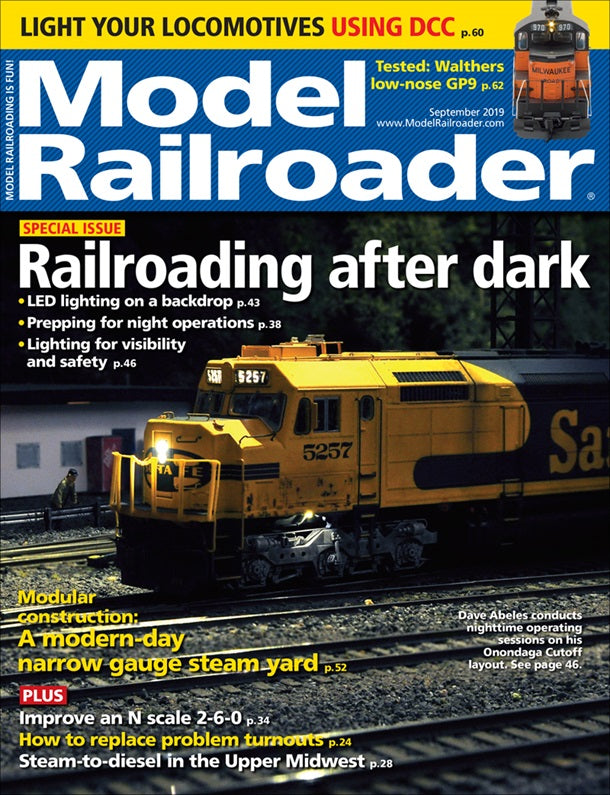Love it? Add to your wishlist
Your favorites, all in one place. Shop quickly and easily with the wishlist feature!
[message]
[title]
[message]

Announcement Date:
Guaranteed Pre-Order Due Date:
Expected Delivery Date:
Individually Boxed:
Chasing trains on the Blueberry Line
by Bob Wundrock
My HO scale Rice Lake, Dallas & Menomonie Ry. (RLD&M) is named after a short line in northwestern Wisconsin that was eventually absorbed into the Soo Line around the turn of the 20th century. The line was known for the blueberry bushes along its route, hence its Blueberry Line nickname. However, my layout portrays the RLD&M in a “what could have been” theme. Instead of a sleepy short line, my RLD&M is a busy main on the Soo that connects the Twin Cities with Duluth, Minn. The time period is the steam-to-diesel transition era in the early 1950s.
The multi-level layout occupies a 17 x 24-foot space with a 2 x 9-foot extension for an interchange yard. It also features a 100-foot-long mainline run. It’s the most complete home layout that I’ve built, but it’s certainly not the first.
Upgrading an N scale steam locomotive
by Lance Mindheim
It seems like it would be easy to find a local modeling theme in the country with the highest rail network density in the world. Nonetheless, some Swiss model railroaders prefer American prototypes.
Huge trains under equally huge Western skies; big cities, big train stations, and big yards; and the nostalgic steamers of the Old West are what Kim Nipkow fell for. His first crush was Union Pacific’s 4-8-8-4 Big Boy.
Nighttime operations on the Virginia & Western
by Douglas Kirkpatrick
What do you do with a finished model railroad? My 25 x 37-foot HO scale Virginia & Western RR (V&W), most recently featured in Model Railroad Planning 2017, has been complete for several years. During that time, I’ve focused on sharing the railroad through regular operating sessions. My friend Steve King guided the initial sessions with his introduction to timetable-train- order operation (TTTO) and other suggestions. After a few bumpy starts, V&W operating sessions evolved into an enjoyable three to four hours of friends running trains.
How to illuminate low-relief buildings
by Mike Hardwick
I recently added interior lighting to several structures on my N scale model railroad and found that it enhanced the realism of early morning and evening operations. A microcontroller randomly and subtly changes the lights, turning them on and off and adjusting the brightness and color. My wife liked the look of the structures and said it would be neat if some of the backdrop buildings had lights, too. I agreed, but wondered how to light the windows of a structure that is only 3⁄4" deep.
I thought of several options for adding lights to my low-relief structures. In the full buildings that already had lights, I placed translucent parchment paper around the LEDs to diffuse the light. Was there a way to do this on a backdrop flat?
Running on the dark side
by Dave Abeles
Railroading is an industry that operates 24 hours a day. The earliest railroads ran during daylight hours and would rest overnight. However, it wasn’t long before someone realized that trains rolled just fine in the dark. All that was needed was a way for crews to see what was ahead at night, and a way for others to see a train coming out of the dark.
A large light on the head end of the locomotive solved both these issues, and a few red lanterns on the caboose or last coach provided markers for the back of the train. The industry quickly became one that worked around the clock. Railroaders are at work as the sun rises, while the sun sets, and throughout the day and the night.
Chama Yard in Switzerland
by Roland Kink
It seems like it would be easy to find a local modeling theme in the country with the highest rail network density in the world. Nonetheless, some Swiss model railroaders prefer American prototypes.
Huge trains under equally huge Western skies; big cities, big train stations, and big yards; and the nostalgic steamers of the Old West are what Kim Nipkow fell for. His first crush was Union Pacific’s 4-8-8-4 Big Boy.
Making a socket for a signal bridge
by Pelle Søeborg
When I installed two BLMA cantilever signal bridges on my former HO scale layout, I wanted them to be easy to remove if I later wanted to use them elsewhere, or just wanted them out of the way while I was working on that part of the model railroad.
I devised a mounting system so I could just plug them in without using any glue to hold them. Basically, I made a socket for each signal and extended the four legs on the signal post with pieces of styrene tube.
Model Railroader has been the leading model train magazine for the past 75 years. Each month, we bring you step-by-step modeling projects, fascinating photo tours of model train layouts, unbiased product reviews, new product announcements, tips from the experts and much more!
177 W Main St
Atlanta, IN 46031
765-292-2022
support@mrmuffinstrains.com
Sign up for our newsletter and be the first to know about coupons and special promotions.
© 2025, MrMuffin'sTrains Powered by Shopify
